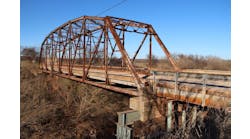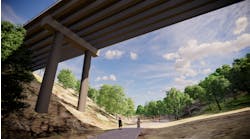If there was ever a bridge in need of an anti-icing solution, it was the Ironwood Bridge on U.S. 20, a heavily traveled route circling South Bend, Ind. Located just 20 miles south of Lake Michigan, the bridge is susceptible to the worst winter conditions. It receives an average of 80 to 90 in. of snow per year—sometimes as much as a foot overnight. Adding to the problem is the bridge’s inclined position on a curve, flanked by sound barriers that block the warming effects of the sun.
Like other cities near the southeast shores of the Great Lakes, South Bend is subject to “lake-effect” snow. This snow is produced when cold winds move across long expanses of warmer lake water and pick up water vapor, which then freezes and deposits on the ground. The effect is magnified when the moving air mass is uplifted, producing snow at a rate of many inches per hour. Freezing mist also is a problem, encouraging the formation of treacherous “black ice” on roads and bridges.
Not surprisingly, traffic safety is a big issue in such areas. Snow and ice can reduce pavement friction and vehicle maneuverability, causing slower speeds, reduced visibility and increased accidents. Nationally, more than 1,100 people were killed and nearly 95,000 people were injured in vehicle crashes on snowy or slushy pavement in 2001, according to the Federal Highway Administration (FHWA). Severe weather conditions also increase road maintenance costs. The FHWA also reports that state and local agencies spend more than $2.3 billion on snow and ice control operations annually and more than $5 million to repair infrastructure damage caused by snow and ice.
The Ironwood Bridge has seen its share of accidents. Statistics gathered by the Indiana DOT indicate that 17 accidents occurred on the bridge, 10 of which were snow and ice related, in a four-year period ending in 1999 (the last time measurements were compiled). Today, the heavily traveled south bypass through South Bend is used by approximately 34,000 vehicles per day (including a fair number of 18-wheelers), all traveling at high speeds.
Scraping the ice plan
The Indiana DOT began using anti-icing chemicals in 1996. Its winter battle plan included a twice-weekly schedule to spray the decks of the Ironwood Bridge. But specific weather conditions were necessary to apply it since the chemicals cannot be applied to the ice on cold or rainy days.Other anti-icing programs would have required applying chemicals at every frost event. However, this option is difficult to budget for and almost impossible to forecast and can cause a bridge to frost over prior to chemical application or plowing.
The DOT also had considered options such as fixed automated anti-icing technology (FAST), a computerized system linked with automated weather reporting that automatically activates spray nozzles and valves to apply the deicing chemical. However, the cost to purchase and maintain such a system was prohibitive.
A new option for increasing safety on the Ironwood Bridge came to light when Indiana DOT engineer Tom Konieczny attended a meeting of the Transportation Research Board. While there, he heard about a new ice protection overlay system that was developed at Michigan Tech University and licensed and marketed by Cargill Deicing Technology.
The SafeLane Ice Prevention overlay system could be applied to prevent frost and ice from ever forming. It offered not only anti-icing characteristics, but the added benefit of better traction on asphalt and concrete.
After investigating further, Konieczny arranged an Indiana DOT contract to have the system installed on the Ironwood Bridge. The installation would be a test to determine how well the overlay worked in the South Bend environment and if proven effective, it could potentially find further application at other bridge locations in the area.
Aggregate storage
The patented technology used in the overlay system is the brainchild of Russ Alger, director of the Institute for Snow Research at Michigan Tech’s Keweenaw Research Center. The center is located on Michigan’s Keweenaw Peninsula, where the area’s unique lake-effect weather conditions—which produce up to 25 ft of snow per year—make it an ideal location for anti-icing and deicing research. As a civil engineer, scientist and inventor with knowledge of pavement design, Alger conducts research to make roads safer through the use of chemicals used in combination with pavement and friction. His studies involve the residual effect of chemicals on pavement to determine which aggregates work better than others in holding chemicals on pavement. The patented technology that is now used in SafeLane Overlay came about after he had conducted research using epoxy overlays to make pavement last longer and remain safer at snowmobile road crossings.For years, deicers have been used to remove ice from bridges and roads, and epoxy overlays have been successful in protecting roadbeds from chloride and water intrusion, but never before have they been used in tandem. The ice prevention overlay combines the pavement sealing and renewal characteristics of epoxy overlays with a unique aggregate that stores and automatically releases anti-icing chemicals as they are needed. A single application can treat multiple frost or ice events.
Wisconsin DOT’s experience at a bridge with the ice prevention overlay in Crandon, Wis., demonstrated that up to 75% less deicer is needed to keep bridge surfaces clear. Instead of anti-icing the bridge twice a week they were able to go as long as every 30 days between chemical anti-icing treatments. The reduced deicer usage produces less runoff, so it benefits the environment. The protective epoxy also reduces the effects of chloride and water intrusion, known as primary catalysts for bridge structure oxidation.
The overlay system has shown promising results in test installations. The Crandon bridge had been the site of several accidents each winter. In a trial that lasted the course of two seasons, no accidents were reported.
Covered in ice prevention
The 400-ft Ironwood Bridge is the longest stretch to receive the overlay treatment. The installation covered 11,790 sq ft and took less than a week in May 2005. The four-lane split bridge has two eastbound lanes and two westbound lanes with a barrier in between. The Indiana DOT opted to install the overlay system on the two eastbound lanes, which are usually the first to ice over. Over the winter, highway professionals will compare the treated and untreated lanes for effectiveness in reducing or preventing ice formation.Laying down the system was a simple process. The first step was to ensure that the surface was in good repair, with no cracks or potholes. The crew also checked for delamination of the concrete. In this case, there were no major issues and the deck was in good shape. The surface was prepped to clean off oils and contaminants, followed by shotblasting to roughen up the surface and ensure a good chemical bond.
Step two was to spread the epoxy on the surface using squeegees and an aggregate spreader. The goal is to keep enough rock exposed to the surface so it will soak up and react with the anti-icing chemical. The rock acts as a reservoir to keep the chemical in place, and the chemical acts to prevent formation of ice crystals from bonding to the surface of the road.
Step three involved allowing the epoxy to set up for about seven to eight hours. After it cured, loose rock was scraped off and vacuumed up, followed by a grinding stage to get out high spots and overly sharp or rough edges.
Preparing for the best (results)
As the winter of 2005-2006 approaches, the Indiana DOT is anxious to monitor the results of the installation, with increased safety as a primary goal.Two cameras have been installed on the bridge site to enable DOT staff to compare traffic on the coated and uncoated lanes to determine how well the system is working. In addition, Alger will travel to Indiana periodically over the winter to work with local highway professionals in assessing the results. “It’s awesome to know what we can do to make a bridge last longer and keep it safer,” Alger said. “It may keep someone from getting in an accident in the middle of the night, especially if crews don’t know when a frost event will happen.” At press time, Indiana’s winter snows have not yet begun. However, DOT professionals have high hopes for the new anti-icing system. Benefits that could result include lower maintenance costs, extended bridge life and simplified scheduling, since crews should be able to apply chemical preventively on their own schedule, rather than after a snow or ice incident occurs.
First and foremost, however, the goal in South Bend is to improve safety and reduce accidents on the Ironwood Bridge. “If we can save one life, it’s well worth it,” Konieczny said.


